Where Can I Find Trivia Near Me Tonight
Did you know that each nation has its own unique way of commemorating Christmas? Have you ever wondered why we send Christmas cards? Decorate an evergreen tree and give it a place of honor in our home? Smooch a sweetheart underneath a parasitic plant? Did you ever wonder how Santa delivers gifts to children all over the world in just one night?
These questions and many more will be answered in this Christmas trivia article that's chock full of interesting, entertaining, and fun facts! Here's a preview:
- Christmas Symbol Trivia
What is the meaning of gold? Frankincense? In this section, find out the significance of these Christmas symbols as you test your Christmas symbol trivia knowledge. - Religious Christmas Trivia
In this section, test your religious Christmas trivia knowledge and learn about the First Live Nativity Scene, the Birthplace of Jesus, and more.
- Christmas Traditions Trivia
Travel to any corner of the world and you'll see how different Christmas traditions can be. Read this trivia article to learn the answers to your questions about Christmas traditions of the world. Expand your Christmas traditions trivia knowledge.
- Santa Trivia
If you think you know all there is to know about Santa Claus, think again! In this section sharpen your Santa trivia skills with facts about Santa's aliases, Santa's favorite reads, and more.
- Christmas Tree Trivia
Where did this Christmas tree tradition come from? What is our great nation's national Christmas tree? Find out answers to these questions and more as you increase your Christmas tree trivia knowledge in this section.
- Christmas Song Trivia
Did you know that carols can be traced back as early as 1350, but most of today's Christmas carols were written during the 18th century? Go to this page to discover entertaining facts like this and more as you test your Christmas song trivia knowledge.
- Christmas Entertainment Trivia
Can you name five classic holiday movies? Theater productions? You can find out answers to these questions and more as you test your Christmas entertainment trivia knowledge with the quick facts in this section of our Christmas trivia article. Visit this page to learn more!
- Christmas Food Trivia
Besides Thanksgiving, Christmas is the only other time of the year where it's perfectly fine for people around the world to overindulge. Why? There are just too many foods and desserts to choose from -- so why not eat them all? Visit this page to learn all about Christmas food as you test your Christmas food trivia knowledge.
- Christmas Gift Trivia
Gift giving at Christmas is a big attraction of the day for many American families. Where did this tradition originate? What are some classic holiday toys? Read this section to find out everything you wanted to know about Christmas gifts as you expand your Christmas gift trivia.
- Christmas Trivia Quiz
In the final section of our Christmas trivia article, we'll let you in on a few more Christmas trivia fun facts. Learn more about Christmas with our Christmas trivia quiz and fun facts in this section.
In the next page of our Christmas trivia article, test your knowledge of the meaning behind the different Christmas symbols.
Want to increase your Christmas knowledge? See:
- Christmas Stories
- Christmas Traditions
- Christmas Crafts
- Christmas Songs
- All Things Christmas
Christmas Symbol Trivia
Christmas is a holiday full of symbollism. Do you know the meanings of the different Christmas symbols? Test your Christmas trivia knowledge with the tidbits below.
What is the Meaning of Gold?
The gift of gold to the Christ Child is supposed to have come from Melchior, a king from Arabia, who, legend has it, was one of the Three Wise Men. His contribution is thought to have financed the Holy Family's flight into Egypt.

Gold came from Melchior.
Gold, as valuable today as it was in Christ's time, symbolizes immortality, divinity, purity, and the kingship of Jesus Christ.
What is the Meaning of Frankincense?
Tradition maintains that Balthasar, one of the Three Wise Men who came from the East to find the Christ Child, presented frankincense to the baby as a gift. By honoring him in this way, Balthasar fulfilled the prophecy that gold and frankincense would be brought from the Gentiles to honor the heavenly king (Isaiah 60 and Psalm 72).
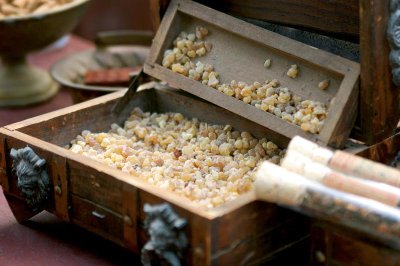
Frankincense is an incense given to the baby Jesus.
Frankincense, a sweet gum resin from the Boswellia tree, is the purest of incense. When burned, it produces white smoke and a sweet smell, symbolizing the prayers and praises of the faithful as well as Christ's sacrifice and the divine name of God.
What is the Meaning of Myrrh?
Caspar, a king from Tarsus and one of the Three Wise Men, is believed to have given myrrh to the Baby Jesus.
Myrrh is known for its medicinal value and was used in ancient times for cleaning wounds and sores, as an analgesic, and for embalming the dead or anointing kings.
Myrrh is actually an aromatic gum resin that oozes from gashes cut in the bark of the commiphora tree. It hardens into teardrop-shaped chunks and is then pounded into powder or mixed to make ointments and perfumes. It is named for its bitter taste and symbolizes the Suffering Savior, the Great Physician, and Christ's human nature.
What is an Advent Wreath?
The season of Advent is the beginning of the church year for Christians. It starts the fourth Sunday before Christmas Day and ends on Christmas Eve. Meaning "arrival," Advent is a celebration of the birth of Jesus and his eventual return.
Many families celebrate this holy season by lighting an Advent wreath. A circular evergreen wreath is laid flat and adorned with four candles around the wreath and one in the center. It is very symbolic of:
- The circular shape of the wreath epitomizes God himself, his endless mercy, and eternity, which has no beginning or end.
- The green pine boughs signify hope in God and eternal life.
- Candles reflect the light of Jesus coming into the world.
The four purple candles around the wreath stand for the four Sundays of Advent and for the four centuries between the time the prophet Malachi predicted the coming of the Messiah and the actual birth of Jesus. One purple candle is lit for each Sunday in Advent, with one candle lit on the first Sunday, two on the second Sunday, and so on, until all four candles are lit on the fourth Sunday. The white center candle symbolizes Christmas Day and is lit on that day.
What is the History of the Christmas Card?

People have been sending
Christmas cards for over 150 years.
The time-honored tradition of sending Christmas cards began more than 150 years ago in England. Sir Henry Cole, a renaissance man who wrote and published books on art and architecture, was too busy to write holiday greetings to friends and family, so he asked John Callcott Horsley, a well-known painter, to design a card with a single message that could be sent to everyone on his list.
Horsley created a lithographed, hand-colored sketch printed on cardboard. The illustration depicted a classic Victorian Christmas scene of a family merrily eating and drinking. The caption read, "A Merry Christmas and a Happy New Year to You."
The first Christmas card appeared in the United States in the mid-1800s, when New York engraver Richard Pease designed a card with a small Santa Claus, a sleigh, and reindeer.
In 1875, Louis Prang, who wrote and published architectural books, printed images in color with a series of lithographic zinc plates. The finished product resembled an oil painting. These cards were so in demand that Prang couldn't fulfill all of his orders. At one point Prang was printing five million cards a year. His efforts earned him the moniker, "The Father of the American Christmas Card."
Today, everything from clever verses and holiday scenes to geometric designs and sports figures grace the fronts of cards. An average U.S. household mails out 28 Christmas cards each year and receives the same number in return. More than three billion Christmas cards are sent annually.
As we've learned, the Christmas symbols often hold religious significance. Test your religious Christmas trivia about the meaning of the nativity scene, the word "Xmas," and the Good King Wenceslas in the next section.
Religious Christmas Trivia
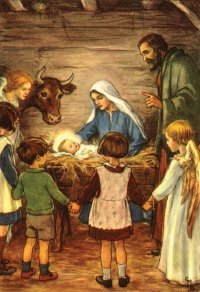
The first Christmas crib was
assembled in 1223.
Test your religious Christmas trivia knowledge with the fun questions on this page. Do you understand the ancient beliefs behind the various Christmas songs? Do you know the meaning of the word "Xmas?" Find out.
Can you Describe the First Live Nativity Scene?
In a cave on a windswept Italian mountainside, Francis of Assisi assembled the first Christmas crib in 1223. The Christ Child, placed on an altar of stone, and two live animals -- an ox and a donkey -- were its only occupants.
Today, a tiny monastery surrounds the cave, which still remains relatively undisturbed by the years. The idea behind the crib was to make the story of Christ's birth more vivid in the minds of shepherds and farmers who lived there. The townspeople were very enthusiastic -- they were the ones who suggested the ox and donkey.
What is the belief behind the Twelve Days of Christmas song?
One of the holiday's best-loved songs, "The Twelve Days of Christmas," marks the longest holiday in the Christian calendar -- the time between Christmas Day and Epiphany, celebrated on January 6.
The song's origin is unknown, but some believe the song was written to help Catholic children remember various articles of faith. These are:
True love
God
A partridge in a pear tree
Jesus
Two turtle doves
Old and New Testaments
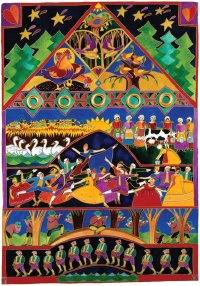
The Twelve Days of Christmas Song
represents the various articles of faith
in Catholicism.
Three French hens
Faith, Hope, and Charity
Four calling birds
Four Gospels
Five golden rings
The first five books of the Old Testament, the Pentateuch, which records the history and laws of ancient Israel
Six geese a-laying
Six days of Creation
Seven swans a-swimming
Seven gifts of the Holy Spirit, or the Seven Sacraments
Eight maids a-milking
Eight beatitudes
Nine ladies dancing
Nine fruits of the Holy Spirit
Ten lords a-leaping
Ten Commandments
Eleven pipers piping
Eleven faithful disciples
Twelve drummers drumming
Twelve points of doctrine in the Apostles' Creed
Where is the World's Largest Nativity Scene located?
With more than 450 figures and hundreds of yards of landscape, the world's largest diorama of the Nativity is found in Einsiedeln, Switzerland. In the 1930s, crib maker Ferdinand Pottmesser built a giant Christmas crib along with hundreds of figurines.
Pottmesser sold the collection to Einsiedeln in the mid-1950s, and the figurines became the impetus for creating a giant diorama -- a copy of the landscape of Bethlehem and a visually accurate representation of the story of the birth of Christ.
The diorama starts with angels awakening the shepherds with news of the birth of Jesus and ends with Joseph and Mary fleeing into Egypt to escape Herod and hissoldiers. The diorama attracts thousands of visitors every year.
What is the Meaning of the Word "Xmas?"
Some people think of Xmas as a contemporary, sacrilegious abbreviation of the word Christmas. On the contrary, the first letter of the word Christ in the Greek language is chi, which is identical to the modern Roman alphabet's X.

Xmas is an ecclesiastical abbreviation.
Therefore, Xmas is an ecclesiastical abbreviation that has been used for almost as long as Christmas has been in existence.
What is the story behind The Birthplace of Jesus?
It was prophesied in Micah 5:2 that Bethlehem would be the birthplace of the future King of the Jews. Indeed, this small Judean city near Jerusalem became the site of the Nativity. Bethlehem, which means "house of bread," was also the home of David, one of God's favorite kings.
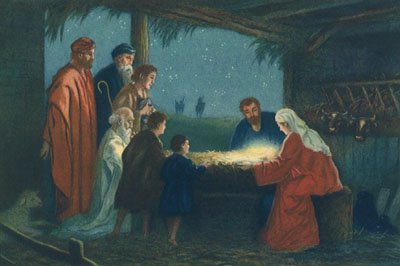
Jesus was born in a stable and laid in a manger.
Though the exact location of Jesus' birth is unknown, the story maintains that Jesus was born in a stable and laid in a manger, or food trough. In those days, stables were made of stones or situated in a cave.
Around A.D. 326-330, Empress Helena, wife of Constantine, built a church over the cave thought to be Jesus' birthplace. The church was rebuilt in the sixth century, and pieces of the original building still remain. It is said to be the oldest Christian church in existence and one of the most genuinely holy sites in the Holy Land.
This altar inside the Church of the Nativity in Bethlehem is believed to mark the exact place of Jesus' birth.
Who was Good King Wenceslas?
"Good King Winceslas looked out on the Feast of Stephen when the snow lay round about deep and crisp and even." King Wenceslas, about whom John Neale wrote this carol, became Duke of Bohemia in A.D. 924. He was a man of great faith who worked diligently to thread Christianity throughout Bohemia.
King Wenceslas served his people very well, especially the children and the poor. But his reign lasted only five years. His brother, Boleslaw, invited Wenceslas to a religious festival, then attacked and murdered him on the way there.
Now that you've discovered some surprising new religious trivia, continue to the next page. There, you'll travel to England, Mexico, and Germany to test your Christmas traditions trivia.
Christmas Traditions Trivia
Christmas traditions around the world can be nearly identical to the way you celebrate Christmas, somewhat the same, or they can be entirely different. Do you know how Christmas is celebrated in Mexico? Germany? Test your Christmas traditions trivia knowledge with the facts below.

There are many different ways Christmas is celebrated around the world.
How do Mexicans celebrate Christmas?
Mexicans celebrate the birth of Jesus with las Posadas, nine days of preparation during which the story of the Nativity is reenacted each day. These days lead up to Noche Buena (Holy Night) or Christmas Eve. Most families go to mass, then head home for dinner with family and friends. The highlight of the evening is placing Baby Jesus in the manger in the Nativity scene.
To prepare for the celebration, the house is decorated with pottery; bowls of fruit; brightly colored paper ornaments; colorful confetti; tinsel-trimmed maracas; star-shaped piñatas filled with oranges, tangerines, peanuts, and candy canes; red, green, and silver tablecloths; small lanterns and candles; and, of course, a Nativity scene.
The spread for Feliz Navidad includes:
- Roast turkey, ham, or suckling pig
- Biscayan cod
- Tamales
- Stuffed chili peppers
- Wild greens in mole sauce
- Atole (beverage made from corn)
- Chili con queso with chips
- Guacamole with flakes of red bell pepper "confetti"
- Ensalada de Navidad (Christmas fruit salad)
- Sidra (sparkling cider)
- Chocolate atole (cinnamon hot chocolate)
- Ponche con piquete (hot punch of fruits and cinnamon sticks)
- Bizcochos (holiday cookies)
- Sweet Christmas fritters
- Flan
What are some of the Swedish Holiday Traditions?
On December 13, one of the darkest days of the year, St. Lucia Day, or the Festival of Lights, is celebrated throughout Sweden to symbolize the promise of the sun's return. In the past, a young girl would dress in a white gown with a red sash and a wreath of lit candles on her head. She would go from house to house offering baked goods.
Today, the tradition continues with the oldest girl in a family wearing the traditional dress with a wreath of (battery-powered) candles on her head, awakening everyone with a song and saffron buns and coffee.
According to legend, Lucia was a young girl that lived during the fourth century. She was blinded for her Christian beliefs. St. Lucia is the patron saint of the blind.
For a Swedish Christmas dinner, sit down to a table of:
- Ham
- Lutefisk (fish soaked in lye)
- Boiled wheat (cuccidata)
- Cabbage pudding
- Baby potatoes
- Sweet carrots
- Medley of vegetables
- Deviled eggs
- Julglögg (a hot, mulled wine)
- Fruit salad
- Saffron buns with raisins
- Rice pudding
- Lingonberry pie
- Broomstick cookies (a lacy cookie with almonds and butter)
- Pepparkakor (sweet ginger)
What is Christmas like in Germany?
Celebrating the season is a month-long event in Germany, with festivities culminating on Christmas Eve, when the Christmas tree is unveiled. Children are not allowed to see the tree until a bell rings to signify that the Christ Child has been there.
Once the tree is revealed, fully decorated with tinsel, lights, and ornaments, families place presents underneath and sing Christmas carols. The night later gives way to a feast so lavish that the evening is often called dickbauch, or "fat stomach."
It is believed that those who do not eat well will be haunted by demons during the night. Nuts, fruits, marzipan, greenery, candles, and adorable carved, wooden figurines of angels, trees, and Santa are placed around the table.

In Germany, the typical Christmas feast
features roasted goose instead of turkey.
The night's delights include:
- Roasted goose
- Ham or suckling pig
- White sausage
- Sausage and cheese bread
- Roasted potatoes
- Green beans
- Yams
- Macaroni salad
- Rice porridge
- Biscuits and marmalade
- Fruit salad
- Apple cider
- Christstollen (bread with nuts, raisins, and dried fruit)
- Lebkuchen (gingerbread)
- Marzipan
What is Boxing Day in England?
Although the exact origin of Boxing Day is unknown, it is believed to date back to England during the Middle Ages. The most widely accepted theory is that even though servants were required to work on Christmas Day, they were given a reprieve the day after to visit family, with their employers sending them off with a box containing gifts and food, hence the term "Boxing Day."
Today, people continue to celebrate by taking the day off to visit family and friends and to give presents to those who have helped them throughout the year. Traditional Christmas festivities in England include tables laden with pine boughs, holly, mistletoe, juniper berries, cinnamon sticks, oranges with fragrant cloves, bowls of fruit, and tiny Christmas trees scattered throughout.

For the Christmas feast in England, turkey and stuffing are staples.
Party favors are placed on plates. These include English "crackers," which are colored paper tubes filled with candy and small gifts.
The typical English Christmas feast consists of:
- Pheasant or chicken
- Turkey
- Assorted sausages
- Stuffing
- Roasted potatoes
- Yams
- Filo crackers
- Mince pies
- Poached pears
- Scones and muffins with berry butter
- Christmas (plum) pudding
- Fruitcake
How do you say "Merry Christmas" around the World?
- Glædelig Jul -- Danish
- Kung His Hsin Nien bing Chu Shen Tan -- Chinese, Mandarin
- Joyeux Noel -- French
- Nadolig Llawen -- Welsh
- Mitho Makosi Kesikansi -- Cree
- Buon Natale -- Italian
- Kala Christouyenna! -- Greek
- Nollaig Shona Dhuit -- Gaelic (Irish)
- Shub Naya Baras -- Hindi
- God Jul -- Swedish
- Boldog Karacsonyt -- Hungarian
- Feliz Navidad -- Spanish
- Pozdrevlyayu s prazdnikom Rozhdestva i s Novim Godom -- Russian
- Sung Tan Chuk Ha -- Korean
- Frohliche Weihnachten -- German
- Gesëende Kersfees -- Afrikaans
- Hyvaa Joulua -- Finnish
- Kurisumasu omedeto -- Japanese
- Mele Kalikimaka -- Hawaiian
- Suksun Wan Christmas -- Thai
- Wesolych Swiat Bozego Narodzenia -- Polish
So, you've learned quite a bit about Christmas traditions around the world and how to say Merry Christmas in more than a dozen languages. Are you ready to test your Santa Claus knowledge? Continue to the next section to test your Santa trivia.
Santa Trivia
Do you believe in Santa Claus? Test your Santa trivia knowledge with the St. Nicholas facts below -- then decide.
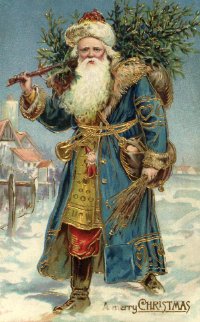
It wasn't until 1809 that Americans had
an actual description and drawing
of St. Nicholas.
Who is Santa Claus?
For centuries, St. Nicholas has been remembered by Christians for his generosity toward children and the poor. The real St. Nicholas lived in Turkey, where he served as bishop in the town of Myra, during the fourth century. According to Dutch legend, Sinter Klaas (St. Nicholas) brought gifts at Christmastime, either through an open window or down a chimney. This legend is the basis of the Santa Claus we know and love today.
Prior to the 16th century, gifts were exchanged during the feast of St. Nicholas on December 6. After that time, German Protestants began celebrating Christkindl on December 25, a feast day for the Christ Child. Soon the two days merged into one, although, today many people in Europe continue to celebrate both days. As early as 1773, the name "St. A Claus" appeared in print.
But Americans did not have a detailed description of St. Nicholas until Washington Irving included a drawing of him in the 1809 publication A History of New York. Then, in 1823, Clement Clarke Moore wrote 'Twas the Night Before Christmas (or A Visit from St. Nicholas). It was Moore's account that characterized Santa as a jolly old man who rides in a sleigh pulled by flying reindeer and slides down chimneys to deliver gifts.
Who's Tracking Santa Claus?
"Deter. Detect. Defend." This motto of the North American Aerospace Defense Command, better known as NORAD, applies to the Canadian and American agency's responsibility to defend the airspace of Canada, Alaska, and the continental United States. However, each December 24, NORAD is also involved in tracking Santa Claus's sleigh ride across the globe.
Using data obtained from a worldwide network of radar and satellites in space, NORAD staff and more than 360 volunteers begin reporting on Santa's progress at 5:00 a.m. MST. Real-time updates via e-mail, the Internet, and telecasts are transferred into streaming audio and video updates and then translated into French, Japanese, Spanish, Portuguese, and English.
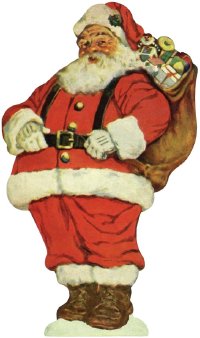
Santa loves to travel to the places
with the most snow!
Which Cities are Easiest for Santa to Visit?
Those with snow, of course! According to the Statistical Abstract of the United States, the average snowfall each December in the following locations is more than two feet:
- Valdez, Alaska
- Yakutat, Alaska
- Blue Canyon, California
- Marquette, Michigan
- Muskegon, Michigan
- Sault Sainte Marie, Michigan
- Mount Washington, New Hampshire
- Syracuse, New York
Does Santa Really Exist?
Yes, Santa Claus really does exist -- and he lives in Rovaniemi, Finland! At Santa's Village, you can visit Santa in his workshop and watch his trusty elves building toys and decorating for the holidays. You can also stop by one of the gift shops and pick up Santa's favorite Finnish candies or a toy from Santa's workshop.
In keeping with Santa's North Pole address, Santa's Village is located in the Finnish Lapland on the Arctic Circle. The Lapland is a region that includes northern Finland, Sweden, and Norway. It is north of the Arctic Circle, an imaginary line on the surface of the earth where the sun does not rise on the winter solstice or set on the summer solstice.
What are Santa's Favorite Reads?
- Olive, the Other Reindeer, J. Otto Seibold and Vivian Walsh
- How the Grinch Stole Christmas, Dr. Seuss
- Saint Francis and the Christmas Donkey, Robert Byrd
- The Polar Express, Chris Van Allsburg
- Christmas in the Big House, Christmas in the Quarters, Patricia C. McKissack and Fredrick L. McKissack
- "The Gift of the Magi," O. Henry
- The Snowman, Raymond Briggs
- The Wild Christmas Reindeer, Jan Brett

One of Santa's favorite reads is Dr. Seuss's How the Grinch Stole Christmas.
What are Santa's Aliases?
Christmas gifts are bestowed by different gift givers in various countries. These include Père Noël in France, St. Nicholas or Sinter Klaas in Holland, Father Christmas in England, the Three Kings in parts of Latin America and Spain, and Santa Claus in the United States. In Germany, children are visited by Christkind, an angelic messenger of Jesus.
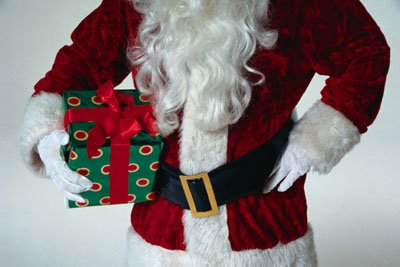
Santa Claus may visit American children, but in Syria, children receive
Christmas gifts from the smallest camel of one of the Three Wise Men.
Babouschka, a grandmotherly figure, brings presents in Russia, while in Sweden, Jultomten, a gnome who rides a sleigh, does the honors. Syrian children receive gifts from a camel of one of the Three Wise Men, reportedly the smallest one in the caravan. And in Italy, a kindly old witch named La Befana leaves gifts for children.
Can you Name any Reindeer Facts?
- Reindeer are one of several subspecies of caribou found around the world.
- Reindeer are herbivores, which means they eat vegetation. In the summer, they eat leaves and herbs. In the winter, they eat lichen and moss.
- Reindeer generally don't run very fast. In fact, a white-tailed deer could outrun a reindeer.
- Reindeer use their antlers like a shovel to break through the crust of snow to reach the vegetation underneath.

Reindeer are healthy herbivores. They feast only on leaves, herbs,
lichen, and moss.
- Reindeer are various colors, including white, dark gray, and brown. Males can have light-colored manes, necks, and shoulders.
- The only female deer to grow antlers are reindeer. Each summer, both males and females grow their wonderful racks, but males usually shed theirs in late November to mid-December. Females keep their antlers until spring. Because all of Santa's reindeer are depicted with antlers, one might conclude that every one of them, including Rudolph, is female.
After testing your Santa trivia knowledge, you should know all there is to know about Santa Claus and his reindeer. Find out how much you know (or think you know) about Christmas trees. Continue to the next page to test your Christmas tree trivia knowledge in the areas of world records, types of Christmas trees, and more.
Christmas Tree Trivia
Christmas just wouldn't be the same without a Christmas tree twinkling in the night on Christmas Eve. Where did this Christmas tree tradition come from? What is our great nation's national Christmas tree? Find out answers to these questions and more as you increase your Christmas tree trivia knowledge with the interesting facts below.
What is the Origin of the Christmas Tree?
The Christmas tree is thought to have originated in a play often performed in the Middle Ages during the Advent season. Based on the story of Adam and Eve, the play featured a Paradise Tree in the Garden of Eden that was decorated with apples to symbolize Eve's temptation. The tree used in the play was an evergreen tree, which symbolized fertility and a renewal of life.

It is believed that the Christmas tree dates back to the Middle Ages.
Later, in 16th century Germany, people would hang apples, gilded candies, colored paper, and roses from tree branches. Martin Luther, inspired by the beauty of stars shining through the branches of a fir tree, is credited with being the first person to add lighted candles to a tree.
Some believe that King George, a native of Germany, brought the tradition of decorating a Christmas tree to England. Others credit Queen Victoria with bringing the tradition to England from Germany where her husband, Prince Albert, was raised.
An etching of the British royal family gathered around a Christmas tree in Windsor Castle in 1848 prompted the spread of this favorite decoration throughout Victorian England. The custom was brought to the United States when German immigrants in Pennsylvania continued to decorate Christmas trees just as they had done in their homeland.
How do you care for Holiday Botanicals?
So much of Christmas decorating involves natural greenery and holiday flowers. Even if you don't have a green thumb, it is easy to incorporate these elements into your decor. All it takes to keep live and cut botanicals fresh during the holidays is tender, loving care.It is a myth that poinsettias are poisonous, but they do have a bitter taste.
To care for poinsettias, keep the soil moist, not wet. After the holidays, transfer the plant into a larger pot, trim the branches back once the bracts or leaves fade, and feed it every three weeks with fertilizer. As the weather warms to 60 degrees Fahrenheit, place the plant outdoors and continue trimming its branches. In October, expose the plant to 14 hours of darkness daily to force the leaves to color.
Holiday greenery such as holly, ivy, and evergreen branches will remain beautiful longer by adding a commercial floral preservative to the water. Spritz arrangements with water daily and monitor their temperature. The cooler the room, the longer the greenery stays fresh. Leaves dipped in household floor wax can last up to six weeks. This also works for decorative fruit such as grapes and pears. It gives them a shine and can keep them from spoiling for at least three weeks.
Christmas trees need water daily. Adding a commercial preservative to the water will extend the life of the tree. For a live tree, place the burlap-wrapped root-ball in a tub, and water it daily. After Christmas, dig a hole twice as large as the root-ball, carefully remove the burlap, then place the tree into the hole.
Ranging in color from red to yellow, kalanchoes and other succulent plants are excellent holiday bloomers. Though the plants can withstand relatively dry conditions, keep the soil moist. After the holidays, treat kalanchoes like poinsettias, trimming the branches and feeding regularly. In the fall, allow the plant to dry out between waterings and expose it to at least 12 hours of darkness to encourage flowering.
To force bulbs like paperwhites, narcissus, amaryllis, and irises, plant them in October with the pointed end up in a shallow container on a layer of pebbles. Fill with sandy potting soil or with more pebbles. Water at planting time and regularly when growth begins. Place the bulbs in warm sunlight, and fertilize just before and during blooming. When flowers begin to die, reduce watering until the leaves have withered. Plant the bulbs, or place them in a cool, dark, dry place until next year.
What is the History of the Wreath?
Wreaths have a long history, dating back to ancient Druids who believed that holly, a perennial evergreen with lush, red berries, was a magical plant. Wreaths were first created when holly and other evergreens were arranged in a circular shape, a shape with no beginning or end, and therefore, synonymous with eternity.
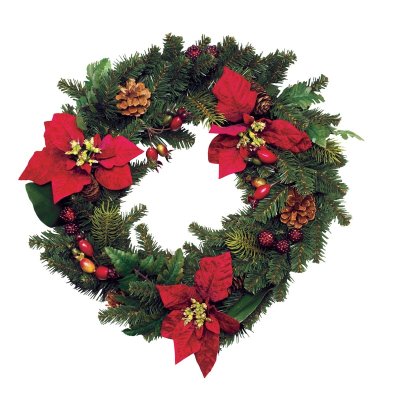
The circular shape of a wreath is synonymous with eternity.
This representation took on more meaning when Jesus Christ was crowned with a wreath of thorns. In the days of Julius Caesar, wreaths were worn by aristocrats and used by Greeks to crown victorious athletes in the original Olympic games. It is believed that hanging a wreath on a door became a custom when Olympic athletes began to hang their wreaths on their doors following a victory.
Although the word wreath evokes thoughts of Christmas, these lovely decorations can beautify doors and walls year-round. They can be embellished with a vast assortment of dried or artificial flowers to fit any holiday or season.
What are some of the most popular Holiday World Records?
Some people love the holidays so much that they set out to break world records with their holiday cheer. For example:
The largest Christmas stocking measures 35 feet 41/2 inches long and 16 feet 5 inches wide. Created by J. Terry Osborne and friends from King William County, Virginia, it was filled with gifts to be distributed to needy children.
Jean-Guy Laquerre of Boucherville, Quebec, Canada, is an avid Father Christmas collector, with more than 13,000 items collected since 1988. The collecting bug bit when his aunt died and left him a 12-inch-high antique papier-mâché Santa Claus from the 1920s. Since then, he has added objects such as music boxes, yo-yos, photos, candleholders, and pens.
What is the Origin of the Poinsettia?
Poinsettias account for 88 percent of all plant purchases at Christmastime. The most popular color is red, but they are also available in white, cream, pink, and yellow, and they can be striped, spotted, or marbled.
Originating in Mexico, where they are known as the "Flower of the Holy Night," the flowers were brought to the United States by Joel Poinsett in 1829. In their native country, they grow as shrubs and can reach heights up to ten feet tall.
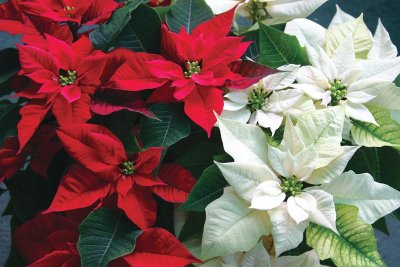
The poinsettia originated in Mexico, where it is known as the
"Flower of the Holy Night."
In Mexico, a heart-warming story explains the origin of the poinsettia:
On a Christmas Eve, long ago, a poor little boy went to church in great sadness because he had no gift to bring the Holy Child. He dared not enter the church, and, kneeling humbly on the ground outside the house of God, he prayed fervently and assured our Lord, with tears, how much he desired to offer him some lovely present --"But I am very poor and dread to approach you with empty hands." When he finally rose from his knees, he saw springing up at his feet a green plant with gorgeous blooms of dazzling red.
What is Holly?
For centuries, holly has been synonymous with the holiday season. In ancient Rome, holly branches were given as a gesture of friendship during Saturnalia, the winter solstice festival. Druids would decorate their homes with holly during Britain's gloomy winters, believing that the sun always shone on this sacred tree. Likewise, pagans would bring holly and other evergreens inside to ensure that Nature would return in the spring.
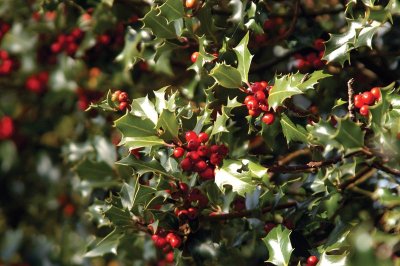
The most well known holly is American holly.
There are hundreds of species of holly that can be clipped and used in seasonal decorations. Perhaps the most well known is American holly, which features spiny, glossy leaves and bright red berries. Inkberry holly, named for its deep purple-black berries, and variegated holly, with striped leaves, are striking alternatives to the standard holiday holly.
What is the Origin of the Traditional Mistletoe Kiss?
Who doesn't love hanging mistletoe? Although most mistletoe is parasitic, and, therefore, harmful to the trees on which it grows, the Celts thought it had magical powers for healing wounds and increasing fertility, so they placed it throughout their homes for good luck and to ward off evil spirits.
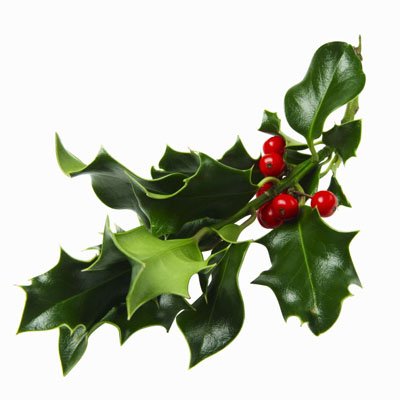
The mistletoe "kiss" tradition dates back to the eighth century.
In ancient Britain, mistletoe was considered so sacred that it could only be cut with a golden sickle. Today, Americans decorate doorframes with this plant in hopes of catching a smooch from a sweetheart while standing under its leaves. This tradition is credited to Frigga, the Scandinavian goddess of love and beauty, and is said to date back to the eighth century.
What is America's National Christmas Tree?
America's official national Christmas tree is not located at the White House, but rather in King's Canyon National Park near Sanger, California. The tree, a giant sequoia known as the General Grant Tree, was designated the "Nation's Christmas Tree" in 1925.
It is 267 feet high, 40 feet across its base, and is estimated to be between 1,500 and 2,000 years old. In 1956, the tree was declared a national shrine to honor the men and women of the U.S. military. As a memorial, park rangers place a wreath at the base of the tree during the Christmas ceremony, which has been held every year since 1925.
As you can see, there were many engaging facts to discover about everything from Christmas trees to wreaths. In the next section, take your Christmas trivia skills to the next level as you uncover facts about Christmas songs.
Continue to the next page to test your Christmas song trivia knowledge.
Christmas Song Trivia
Did you know that carols can be traced back to as early as 1350, but most of today's Christmas carols were written during the 18th century? You can discover entertaining facts like this and more as you test your Christmas song trivia knowledge with the tidbits below.
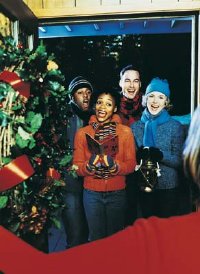
Holiday carols can be traced back
to the 1800's.
What is the Origin of Holiday Carols?
In 1847, the music for "O Holy Night" was written by French composer Adolphe-Charles Adam, who also wrote the ballet Giselle. Now a mainstay for church celebrations and carolers, the song was first denounced by church authorities for its "lack of musical taste and total absence of the spirit of religion." The English words to the song were translated from French by American clergyman John Sullivan Dwight.
In 1857, James Pierpont, musical director at his brother's Unitarian church, was inspired to write a song about the rollicking sleigh races he watched as a young man. "Jingle Bells" was first published as "One Horse Open Sleigh," and though it was well liked from the beginning, it really took off when the Hayden Quartet recorded it in 1902.
Pastor Phillips Brooks wrote the words to "O Little Town of Bethlehem" in 1867, recalling the view of Bethlehem from the hills of Palestine at night. His church organist, Lewis Redner, added the music so that the children's choir could sing the song. The song "Jolly Old St. Nicholas" is usually considered anonymous, but some people claim that it was written by Wilf Carter, also known as country singer Montana Slim.
What is the Biggest Selling Christmas Song of all time?
According to the Guinness Book of World Records, "White Christmas" has sold more than 100 million copies around the world. The song was written by Irving Berlin and recorded by Bing Crosby for the 1942 musical Holiday Inn.
The song appeared again in the 1954 film White Christmas, which starred Crosby. According to the American Society of Composers, Authors, and Publishers (ASCAP), there are more than 500 versions of "White Christmas" in dozens of languages, making it the most recorded holiday song.
Released annually since 1942, the song's last chart appearance was in 1998, when it reached number 29 in the United Kingdom.
Who has recorded "Everybody's Doing the Jingle Bell Rock?"
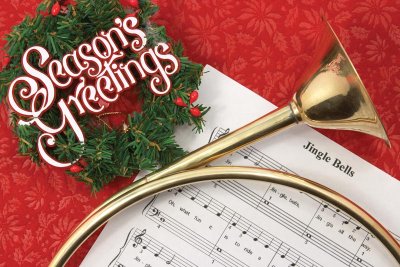
Artists from Neil Diamond to Hilary Duff have recorded "Jingle Bell Rock."
Released in 1957, "Jingle Bell Rock" has been a favorite of recording artists for nearly 50 years. Who has recorded this tune?
- 1957Bobby Helms
- 1961Chet Atkins
- 1961Eddy Arnold
- 1961Bobby Rydell and Chubby Checker
- 1962Bobby Vee
- 1963The Platters
- 1964Brenda Lee
- 1968Herb Alpert
- 1969Johnny Mathis
- 1970Bobby Sherman
- 1971Lynn Anderson
- 1984Elmo & Patsy
- 1990Wild Rose
- 1992Neil Diamond
- 1992Glen Campbell
- 1993Vince Gill
- 1994John Anderson
- 1995Dion
- 1996Flash Cadillac
- 1999George Strait
- 1999Amy Grant
- 2000Billy Gilman
- 2000Ricky Van Shelton
- 2003Hilary Duff
In what year did the World's Largest Caroling Service take place?
The world's largest caroling service took place December 20, 2003, as recorded by the Guinness Book of World Records. Organized by the City of Cambridge in Ontario, Canada, 1,175 carolers sang Christmas songs in the Civic Square for 28 minutes.
What is The Vienna Boys' Choir?
Giving voice to the holidays, the Vienna Boys' Choir is one of the oldest boys' choirs in the world. According to founding documents, the choir has roots as far back as 1498, when Maximilian I brought a dozen boys together to form the court music band.
As expected, the choir has produced many musicians that shaped the musical history of the 19th and 20th centuries, including composers Joseph and Michael Haydn. Franz Schubert wrote his first compositions as a court choirboy, and although he was considered a musical genius, he was not a favorite of his teachers since he was more interested in writing music than in getting good grades for his schoolwork.
In 1924, the choir began singing in concert halls around the world. Since then, the Vienna Boys' Choir has performed concerts under many great conductors, including Leonard Bernstein. Yet, in keeping with a tradition dating back to 1498, the choir sings solemn mass in Vienna's Hofburg Chapel every Sunday.
What is the Radio City Music Hall Christmas Spectacular?
Since 1933, the Radio City Music Hall Christmas Spectacular has been a mainstay for the holidays in New York City. Originally performed before movie screenings, the Christmas Spectacular expanded to its current 90-minute live stage production in 1979.
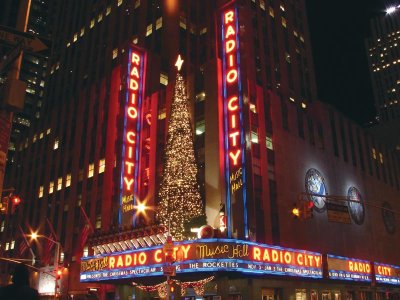
During Radio City Music Hall Christmas Spectacular show's run,
2,500 pounds of "snow" fall upon the stage.
For eight weeks each year, the show attracts more than a million people to its Big Apple performances, and thousands more catch its holiday tour to major cities around the United States. It is the number one live show in the country. Part of the allure of the show is its over-the-top presentation:
- The cast changes costumes eight times during the show, with as little as 78 seconds to do so. In all, there are 1,300 costumes worn.
- During the "Music Hall Menagerie," two donkeys, three camels, five sheep, and a horse make a special appearance. They have their own staff of trainers offstage.
- A real ice rink built on a movable platform is used during the "Christmas in New York" scene.
- The "Here Comes Santa Claus" number features every member of the cast dressed as Santa to explain how Santa can actually deliver gifts to every boy and girl in the world, all in one night.
- During the show's run, 2,500 pounds of "snow" fall upon the stage.
What are the Top 20 Christmas Songs?
According to ASCAP, these are the most-performed holiday songs from 2000 to 2005:
- "The Christmas Song" (Chestnuts Roasting on an Open Fire) (Mel Tormé, Robert Wells)
- "Santa Claus Is Coming to Town" (J. Fred Coots, Haven Gillespie)
- "Have Yourself a Merry Little Christmas" (Ralph Blane, Hugh Martin)
- "Winter Wonderland" (Felix Bernard, Richard B. Smith)
- "White Christmas" (Irving Berlin)
- "Let It Snow! Let It Snow! Let It Snow!" (Sammy Cahn, Jule Styne)
- "Rudolph the Red-Nosed Reindeer" (Johnny Marks)
- "Jingle Bell Rock" (Joseph Carleton Beal, James Ross Boothe)
- "I'll Be Home for Christmas" (Walter Kent, Kim Gannon, Buck Ram)
- "Little Drummer Boy" (Katherine K. Davis, Henry V. Onorati, Harry Simeone)
- "Sleigh Ride" (Leroy Anderson, Mitchell Parish)
- "It's the Most Wonderful Time of the Year" (Edward Pola, George Wyle)
- "Silver Bells" (Jay Livingston, Ray Evans)
- "Rockin' Around the Christmas Tree" (Johnny Marks)
- "Feliz Navidad" (José Feliciano)
- "Blue Christmas" (Billy Hayes, Jay W. Johnson)
- "Frosty the Snowman" (Steve Nelson, Walter E. Rollins)
- "A Holly Jolly Christmas" (Johnny Marks)
- "I Saw Mommy Kissing Santa Claus" (Tommie Connor)
- "Here Comes Santa Claus" (Gene Autry, Oakley Haldeman)
If you thought your Christmas song trivia knowledge was pretty good, then you may do very well with our next section. Let's continue in the area of art and entertainment and find out how much you know about Christmas entertainment.
Christmas Entertainment Trivia
There are more classic movies, productions, and songs played during Christmas than any other time of the year. Can you name five classic holiday movies? Theater productions? You can find out answers to these questions and more as you test your Christmas entertainment trivia knowledge with the quick facts below.
What are titles of some of the Classic Holiday Movies?
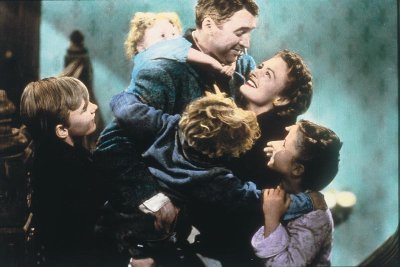
It's a Wonderful Life is a classic holiday movie.
- Miracle on 34th Street
- It's a Wonderful Life
- Holiday Inn
- White Christmas
- The Lemon Drop Kid
- Rudolph the Red-Nosed Reindeer
- The Santa Clause
- A Christmas Story
- Home Alone
- Santa Claus is Comin' to Town
- How the Grinch Stole Christmas
- A Christmas Carol
- Scrooged
- National Lampoon's Christmas Vacation
Do you know the history of Holidays at Rockefeller Center?
In New York, it's not officially Christmastime until the tree is lit at Rockefeller Center. The first tree appeared in 1931, during the Great Depression, when workers placed a tree in the dirt of a construction site. That year, the tree symbolized Christmas as much as it did hope and the invincible human spirit.
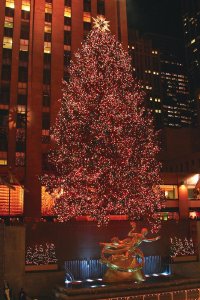
The Christmas tree at Rockefeller Center
is adorned with more than 25,000 lights.
In 1933, the current tradition began with a tree decorated with 700 lights placed in front of the newly completed RCA Building. The Rockefeller Plaza Outdoor Ice-Skating Pond opened in 1936.
The decorating themes and festivities have varied from year to year. In 1941, two reindeer borrowed from the Bronx Zoo were housed in cages beside the Prometheus Fountain. In 1942, during World War II, three living trees graced the Center.
In an act of patriotism, one tree was decorated in red, another in white, and the other in blue. However, because of wartime restrictions on electricity, the trees were not illuminated.
In 1949, the tree was painted silver. In 1951, the entire nation witnessed the tree-lighting ceremony when it was televised on The Kate Smith Show. And by 1964, the ceremony had become an annual event, with celebrities such as Johnny Carson, Hugh Downs, Ed McMahon, Barbara Walters, Debbie Reynolds, Marlo Thomas, and Phil Donahue hosting the show.
Today, the annual Christmas tree at Rockefeller Center is typically adorned with more than 25,000 lights but no other ornaments except for the star on top.
Who is Rankin-Bass?
Rudolph, Frosty, and Kris Kringle were all brought to life on television, thanks to the work of Rankin-Bass. The television production company founded by Arthur Rankin, Jr., and Jules Bass achieved fame in 1964 when they created an animated adaptation of the song "Rudolph the Red-Nosed Reindeer."
Narrated by Burl Ives, with an original orchestral score by Johnny Marks, Rudolph the Red-Nosed Reindeer was an instant hit and today is one of the longest-running Christmas specials in television history.
Rudolph's success was soon followed by several other holiday hits produced by Rankin-Bass:
- "The Little Drummer Boy," 1968, narrated by Greer Garson, featured the Vienna Boys' Choir
- "Frosty the Snowman," 1969, narrated by Jimmy Durante, with Jackie Vernon as Frosty
- "Santa Claus Is Comin' to Town," 1970, narrated by Fred Astaire, with Mickey Rooney as Kris Kringle
- "Frosty's Winter Wonderland," 1976, narrated by Andy Griffith and starred Shelley Winters as Crystal
- "Rudolph's Shiny New Year," 1976, with Red Skelton as Father Time
- "Nestor, the Long-Eared Christmas Donkey", 1977, featured original music by Gene Autry
- "Jack Frost," 1979, with songs written by Al Jolsen and Mel Tormé

The 1983 film A Christmas Story became an instant classic.
Rankin-Bass Trivia: What animated shows did Rankin-Bass create in the 1970s?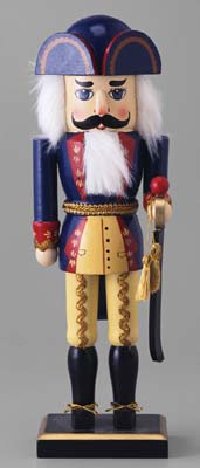
The Nutcracker is a full-length ballet,
based on The Nutcracker of Nuremberg.
- Though all of the later merchandise from Rudolph the Red-Nosed Reindeer features "Herbie," the elf-turned-dentist, his actual name is "Hermey."
- In the 1970s, Rankin-Bass created animated versions of The Jackson Five Show and The Osmonds.
- Rankin-Bass television specials were produced using stop-motion animation. This early type of technology gives the appearance that still objects are moving.
The object is photographed in a single frame, then moved ever so slightly before being photographed again.
When the frames are put together, the objects appear to move by themselves. Stop-motion animation is similar to a cartoon but is produced with real objects instead of drawings.
What is The Nutcracker?
In 1890, following the success of the Russian ballets Swan Lake and Sleeping Beauty, composer Peter Tchaikovsky, choreographers Marius Petipa and Lev Ivanov, and set designer Ivan Vsevolozhsky created what would become one of the best-loved ballets of all time.
The Nutcracker, a full-length ballet, was based on The Nutcracker of Nuremberg, by Alexandre Dumas, which he adapted from The Nutcracker and the Mouse King, by German writer E.T.A. Hoffman. In December 1892, the ballet opened at the Mariinsky Theatre of Russia to mixed reviews.
It wasn't until 1944 that an American ballet company performed the masterpiece. Choreographed by W. Christensen, the San Francisco Opera Ballet produced the first full-length American production, with Jocelyn Vollmar dancing as the Snow Queen.
So you've had your fill of Christmas entertainment trivia, and you're hungry for more. Continue to the next section to test your Christmas food knowledge with our fun Christmas food trivia questions.
Christmas Food Trivia
Besides Thanksgiving, Christmas is the only other time of the year where it's perfectly fine for people around the world to overindulge. There are so many delicious Christmas foods and desserts to choose from, its no wonder the average American eats 17 pounds of turkey each year!
Learn all about Christmas food as you test your Christmas food trivia knowledge with the tidbits below.

In America, Christmas dinner wouldn't
be complete without turkey.
What's for Christmas Dinner in America?
- Baked ham
- Turkey and stuffing
- Mashed potatoes and gravy
- Sweet potatoes
- Green bean casserole
- Winter squash soup
- Waldorf salad
- Cranberry salad
- Parker house rolls
- Divinity
- Red velvet cake
- Pumpkin pie
How many Turkeys are Consumed at Christmas each Year?
- The largest turkey on record weighed 86 pounds, about the size of a large dog.
- Native Americans used turkey feathers to stabilize arrows.
- Twenty-two million turkeys are consumed each year at Christmas, compared to 45 million at Thanksgiving.
- On average, each American eats more than 17 pounds of turkey annually.
What is Figgy Pudding?
Before you sing, "Now bring us some figgy pudding," it might be helpful to know exactly what you are requesting. Figgy pudding is an English dish similar to bread pudding. Made from figs, bread crumbs, cinnamon, nutmeg, and milk, the pudding is baked, then topped with a scrumptious brandied hard sauce, custard icing, powdered sugar, or whipped cream.
The dish was immortalized in the song We Wish You a Merry Christmas and was served by Mrs. Cratchit in the Charles Dickens classic A Christmas Carol.
What is fruitcake?
Fruitcake früt-k¯ak n (1848) 1: a rich cake containing nuts, dried or candied fruits, and spices; 2: a foolish, eccentric, or crazy person.
What is Christmas without fruitcake? Indeed, this chewy, rich confection is a staple of the holidays, but what, exactly, is it? It is called a cake, but because it is chock-full of nuts and candied fruits, it resembles a candy bar. When sliced, pieces can be passed off as cookies.
In ancient times, fruitcake was made with raisins, pomegranate seeds, and pine nuts mixed together with barley mash. Later, honey, spices, and candied fruits were added. Because of fruitcake's consistency and longevity, early warriors and hunters carried it with them on long journeys.
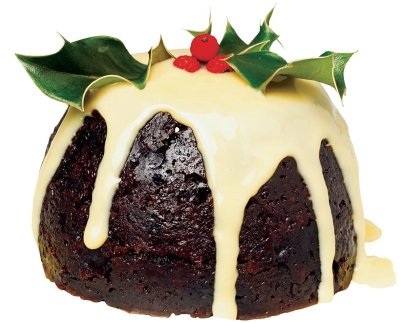
This rich fruitcake is a staple of the holidays.
In the 1700s, Europeans baked ceremonial fruitcakes at the end of the nut harvest, saved them, and then ate them at the beginning of the next year's harvest. This was done with the hope that it would bring another successful harvest.
Also, throughout Europe during this time, the consumption of fruitcake (also called plum cake) was restricted to special occasions because of its "sinfully rich" taste. Those laws were later rescinded, and fruitcake became an essential of the Victorian tea era.
In 18th-century England, it was believed that unmarried wedding guests who put a slice of fruitcake under their pillow at night would dream of the person they were destined to marry.
What is The Legend of Bûche de Noël?
A classic French dessert, Bûche de Noël is a delicious confection of chocolate cake and rich pastry cream rolled into the shape of a log. The cake symbolizes the belief that a large log should burn continuously on Christmas night.
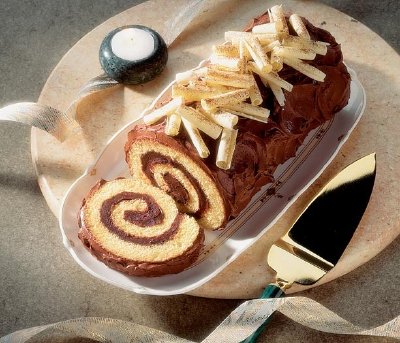
Bûche de Noël symbolizes the belief that a large log should burn
continuously on Christmas night.
If it goes out, it means bad luck in the coming year. The next morning, the ashes from the log are scooped up and kept as a good luck charm to heal sickness, bring on needed rain, and guarantee success in business.
What is Gingerbread?
Whether baked into delicious spiced cakes or crunchy, flat cookies, or used to build a "house," gingerbread has been a European delicacy for centuries. As the dessert spread throughout Western Europe, ginger-bread became a part of local traditions. In England, unmarried women would eat gingerbread "husbands" for luck in meeting the real thing.

The famous lebkuchen gingerbread in Nuremberg is considered to be
the best gingerbread in the world.
On festival days, images of saints would be stamped in gingerbread and sometimes iced. Today, gingerbread is often associated with Germany and its holiday traditions. Gingerbread hearts are commonly found at fall fairs, decorated with colored icing and tied with ribbons.
In December in Nuremburg, the "gingerbread capital of the world," the Christkindlmarkt features the famous lebkuchen, which is considered to be the best gingerbread in the world.
Can you name the most Popular Holiday Treats?
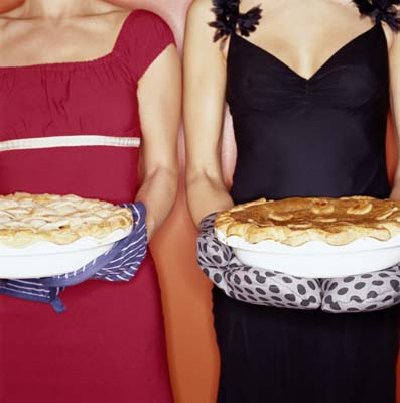
Some popular holiday treats include mince pie, pumpkin pie, and fruitcake.
- Candy canes
- Gingerbread
- Chestnuts
- Fruitcake
- Bûche de Noël or Yule log cake
- Rum balls
- Chocolate truffles
- Meringue kisses
- Divinity
- Mince pie
- Pumpkin pie
- Homemade fudge
- Frosted sugar cookies
- Toffee
So you've learned about everything from figgy pudding and fruitcake to interesting facts about turkey. Are you ready to exchange some unusual facts about Christmas gifts? Continue to the next section to test your Christmas gift trivia knowledge.
Christmas Gift Trivia

The first Christmas gifts were
from the Magi to the baby Jesus.
For many American family, gift giving at Christmas is a big attraction of the day. Where did this tradition originate? What are some classic holiday toys?
Find out everything you wanted to know about Christmas gifts as you expand your Christmas gift trivia with the fun facts below.
What is the Origin of Gift Giving?
The first gifts given at Christmas were from the Magi (Wise Men) to Baby Jesus. Later, in Roman times, gift giving was popular during Saturnalia, a winter solstice celebration. The tradition as we know it today is derived from St. Nicholas, a bishop who was known for giving children presents.
His long flowing red and white bishop's robes were the inspiration for Santa's modern-day costume. St. Nicholas Day, celebrated on December 6, marks a day for gift giving throughout Europe.
Did You Know?
- You can spend your holidays in these destinations: Christmas, Florida; Santa Claus, Indiana; Noel, Missouri; and Rudolph, Wisconsin.
- The Salvation Army collection kettle evolved from a large stewing pot set out in the streets of San Francisco in 1891 to collect money to provide Christmas dinner to 1,000 of the city's poorest residents.
- In the United States, many retailers make up to 70 percent of their annual revenues in the month preceding Christmas.
- More diamonds are purchased during the Christmas season than at any other time of the year.
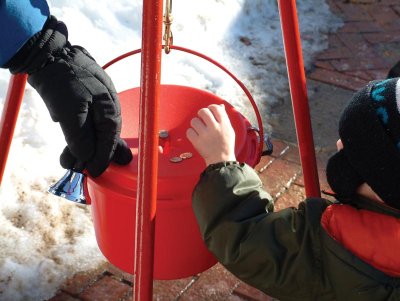
The original Salvation Army collection kettle was a large stewing pot.
Can you Name Five Classic Holiday Toys?
Can't decide what to get the little tyke? Check out this list of America's favorite toys over the years, compiled by the Toy Industry Association.
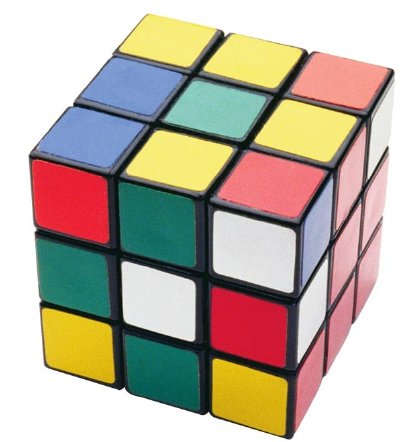
The Rubik's Cube® is considered a classic holiday toy.
- Parcheesi® game 1867
- Lionel® train 1900
- Crayola® crayons 1900
- Teddy bear 1903
- Rook® game 1906
- Tinkertoys® 1914
- Lincoln Logs® 1916
- Radio Flyer® wagon 1917
- LEGO® building set 1930
- View-Master® 3D viewer1938
- Candy Land® 1949
- Silly Putty® 1950
- Mr. Potato Head® 1952
- Play-Doh® 1955
- Barbie® doll 1959
- Etch-A-Sketch® 1960
- G.I. Joe® 1963
- Easy Bake Oven® 1963
- Twister® 1966
- Spirograph® 1966
- Hot Wheels® racecar set1968
- Rubik's Cube® 1979
- Cabbage Patch Kids® 1983
- Trivial Pursuit® 1983
- Magna Doodle® 1986
- Pictionary® 1987
- Teenage Mutant Ninja Turtles™1988
What are America's Favorite Stocking Stuffers?
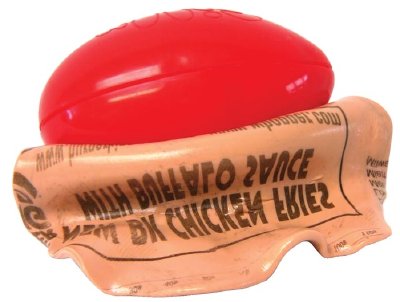
Silly Putty® is one of America's favorite stocking stuffers.
- Candy
- Nuts
- Oranges
- CDs and DVDs
- Small stuffed animals
- Playing cards
- Silly Putty®
- Lifesavers® Sweet Storybooks
- Money
- Stickers and stamps
- Little dolls and toy cars
- Crayons and markers
- Movie tickets
- Books
- Lottery tickets
- Lumps of coal
What is Toys for Tots?
In 1947 Diane Hendricks asked her husband, Bill, a major with the U.S. Marine Corps Reserves in Los Angeles to deliver a doll she had made to an agency that gave toys to needy children at Christmastime. He soon discovered that no such agency existed, so Diane encouraged him to start one. That Christmas, Bill and a group of Marine reservists delivered 5,000 toys.
The project was so successful that, in 1948, the Marine Corps adopted the Toys for Tots program and extended it across the nation. And so the legendary holiday charity was born. For the first national campaign, Walt Disney designed a poster for the program, as well as the Toys for Tots logo that is still used today. Through the years, celebrities have continued to lend their stature to the program.
In 1956, Nat "King" Cole, Peggy Lee, and Vic Damone recorded a Toys for Tots theme song written by Sammy Fain and Paul Webster. Bob Hope, John Wayne, Tim Allen, and Billy Ray Cyrus are among those who have volunteered their time and talents.
Since 1947, more than 335 million toys have been delivered to nearly 160 million children in approximately 500 communities across the United States and Puerto Rico. Without a doubt, the U.S. Marines play a major role in bringing joy to America's needy children at Christmastime.
Toys for Tots continues to be a popular charity with celebrities. In 2003, the New Jersey Nets Dance Team pitched in to support the Marines in their toy drive.
In 1914, to boost sales for his new invention, Charles Pajeau hired little people, dressed them as elves, and had them play with his Tinkertoys® set in the display window of a Chicago department store. The merchandising ploy was overwhelmingly successful. Over the next year, more than a million sets of Tinkertoys® were sold.
Toy Trivia: What American Toy was Banned in Japan in the late 1950's?
- Mattel sells two Barbie® dolls per second, and 90 percent of American girls have had at least one Barbie® doll.
- The first toy advertised on television was Mr. Potato Head® in 1952. Parents had to provide children with a real potato for the body until Hasbro introduced the hard plastic body in 1964.
- In the United States, nearly 25 million hula-hoops were sold in just four months during 1958 and 1959. However, the toy was banned in Japan and the USSR as a "symbol of the emptiness of American culture."
- The world's leading vehicle tire manufacturer is not Michelin or Firestone, but the LEGO Group, which produces more than 300 million tiny tires annually.
- Game of the Century: Monopoly®
- Toy of the Century: LEGO®
What Types of Materials were used to Wrap Gifts in the 1900s?
Believe it or not, Christmas gifts haven't always been presented wrapped in pretty paper. In the early days, toys and candies were dangled from the Christmas tree.
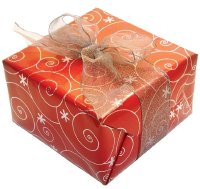
In the early 1900s, gifts were wrapped in white tissue paper
and red satin ribbon.
In the early 1900s, presents were wrapped in white tissue paper and red satin ribbon, with a bit of holly or fresh pine tucked into the ribbon. Straight pins were used to hold the paper together until tape became the standard.
By now, you should have more than enough Christmas trivia to carry you through the holiday season. Let's wrap things up with a final trivia test.Take a Christmas trivia quiz in our final section.
Christmas Trivia Quiz
Just when you thought you knew everything about Christmas, we've uncovered more Christmas trivia fun facts. Learn more about Christmas with our Christmas trivia quiz and fun facts below.
Christmas Trivia: Fun Facts
- Q: How much does the average American family spend on Christmas gifts?
A: The average American family spends about $800 on Christmas gifts every year. - Q: How many Christmas trees are sold each year?
A: Thirty-seven million fresh Christmas trees are sold each year. - Q: What state first recognized Christmas as an official holiday?
A: Alabama was the first state to recognize Christmas as an official holiday, starting in 1836. - Q: How many candy canes are made each year?
A: More than 1.76 billion candy canes are made annually for the Christmas season. - Q: Why do Barnum's animal crackers have a string handle?
A: Barnum's animal crackers in the circus-themed box were designed with a string handle so they could hang on a Christmas tree. - Q: What are sugarplums?
A: Sugarplums are actually chocolate candies with cream, fruit preserves, or other sweet fillings inside. - Q: What is wassail?
A: Wassail is a beverage dating back to the Middle Ages. The word is derived from the Old Norse ves heill, meaning "in good health." This evolved into visiting neighbors on Christmas Eve and drinking to their health.Traditional wassail contained ale, wine, or hard cider topped with beaten eggs or stale bread. Modern recipes for wassail use hot apple cider simmered with spices and sweetened with honey. - Q: Why are candy canes bent?
A: In 1670, a choirmaster in Cologne, Germany, bent the ends to resemble a shepherd's staff and handed them out to children during church services to keep them quiet. In the early 1900s, candy canes acquired their famous stripes. The first candy canes were straight, white sticks of sugar candy used as Christmas tree decorations. - Q: Why do people eat mincemeat pie on Christmas?
A: Eating mincemeat pie on Christmas dates back to the 16th century. Traditionally, it was thought that eating a small pie on each of the 12 days of Christmas would bring good luck in the New Year.
Congratulations! You're ready to make it through our Christmas quiz with flying colors. Or, if you still need moreChristmas knowledge, check out these links:
- Christmas Stories
- Christmas Traditions
- Christmas Crafts
- Christmas Songs
- All Things Christmas
Where Can I Find Trivia Near Me Tonight
Source: https://people.howstuffworks.com/culture-traditions/holidays-christmas/christmas-trivia.htm#pt10
0 Response to "Where Can I Find Trivia Near Me Tonight"
Postar um comentário